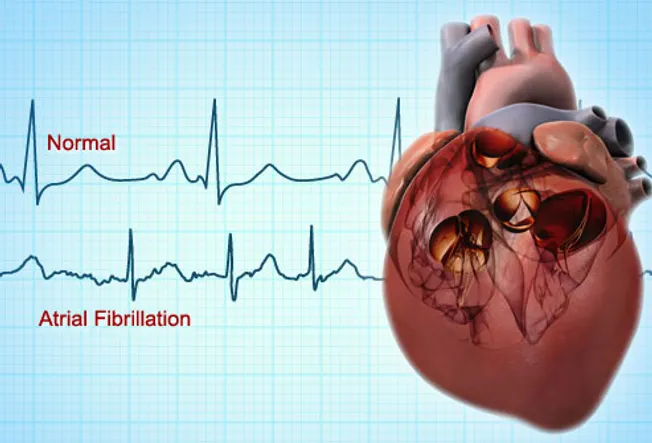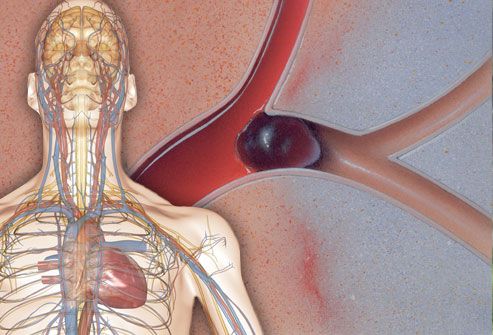Atrial Fibrillation

What Is Atrial Fibrillation?
Atrial fibrillation (AFib) is a condition that disrupts the body's regular heartbeat. A glitch in the heart’s electrical system makes the upper chambers (the atria) quiver. This causes the lower chambers (the ventricles) to beat irregularly. AFib can be dangerous because it raises the risk of stroke and heart failure.
Warning Signs:
1)Uneven Pulse
In many people, AFib does not cause obvious warning signs. When symptoms do occur, they often include:
An uneven pulse
A racing or pounding heart
A feeling that the heart is fluttering
Chest pain
2)Dizziness
An irregular heartbeat can take a toll on the body, leading to problems such as:
Dizziness
Breathlessness
Weakness and fatigue
Fainting
Normal Heart Rhythm vs. AFib
Electrical signals between the atria and ventricles help the heart pump blood in steady rhythm. In AFib, the atria fire abnormal signals, which make the top chambers quiver rapidly. The result can be irregular contractions that can cause a fast, irregular heart rate (100-175 beats per minute). The normal range is 60-100 beats per minute.

AFib and Stroke
If the heart isn’t pumping like it should, blood can pool and may form a clot. This clot can travel through the bloodstream to the brain, causing a stroke. People with AFib are five times more likely to have a stroke than those without it.
When to Seek Emergency Care
AFib is not always an emergency, but you should call 911 if you have any of these symptoms:
Severe chest pain
Uneven pulse and feeling faint
Signs of a stroke, such as numbness or slurred speech
What Causes AFib?
The most common triggers are conditions that strain the heart, including:
High blood pressure
Coronary artery disease and heart attacks
Heart failure
Problems with the heart valves
In some cases, AFib may come from thyroid disorders or serious infections like pneumonia.
Risk Factors Not Under Your Control
Besides heart conditions, there are several factors that raise your risk of developing AFib.
Being male and white
Being over age 60
A family history of AFib
Risk Factors Which Are Under Your Control
Obesity
Lung disease
Certain prescription drugs like albuterol
Stimulants, including some illegal drugs, and heavy use of nicotine
Drinking too much alcohol
Heart Surgery Can Be a Trigger
Having a coronary artery bypass or other type of heart surgery can trigger AFib. When AFib happens after surgery, it increases the risk of other complications. The good news is this type of AFib is usually short-lived.
Lone AFib
Sometimes AFib happens without an obvious trigger. This is called lone AFib, and it’s more common in people younger than 65. You may need treatment if a rapid heartbeat causes troubling symptoms. Doctors may recommend treating lone AFib to reduce the risk of stroke in certain people.
Diagnosing AFib: EKG
The surest way to detect AFib is with an electrocardiogram (EKG). This painless test records the electrical activity of your heart and reveals problems with the heart’s rhythm. You can take the test in a doctor’s office, or your doctor may ask you to wear a device that records your heart’s activity continuously for 24 hours or more.
Other Tests for AFib
If an EKG shows that you have AFib, your doctor may order other tests to learn more about your heart. An echocardiogram or ultrasound of the heart can show whether there is any valve damage or signs of heart failure. A stress test can show how well your heart is performing. Your doctor may also order tests to look for conditions that may have triggered your AFib.
The Course of AFib
When people first develop AFib, it may come and go. The irregular heart rhythm may last anywhere from a few seconds to a few weeks before returning to normal. In some people, the heart rhythm can remain irregular. If the trigger is a thyroid problem, pneumonia, or other treatable illness, AFib usually goes away once the cause is treated.
Types of Treatment:
1) Cardio-version
In some cases, your doctor may try to restore a normal heart rhythm with an electrical shock or medication. This is known as cardio-version. If you’ve been having AFib for more than 48 hours, cardio-version could raise your risk of stroke. In that case, you may need to take a blood thinner for several weeks before your doctor tries it, as well as after cardio-version.
2) Medication
If your symptoms are mild, or if AFib comes back after cardio-version, you may be able to control it with medicine. Rhythm-control medicines help regulate your heart rhythm. Rate-control medicines keep your heart from beating too fast. Daily aspirin or anti-clotting medicines such as dabigatran, rivaroxaban, or warfarin can help reduce the risk of stroke in certain people with AFib.
3) Ablation
If cardio-version and medications can't control the symptoms of AFib, radio-frequency ablation may help. This procedure uses radiofrequency energy to destroy the heart tissue that sends out faulty electrical signals. Although it does not require open heart surgery, ablation has some risks. It is only recommended for people who have serious symptoms despite trying other treatments.
4) Surgery
A type of surgery called the maze procedure can cure AFib. Doctors make a pattern of small cuts to create scar tissue in the atria. The scar tissue blocks the abnormal signals that cause AFib. Doctors usually do this procedure during open heart surgery, but some medical centres are now offering a minimally invasive procedure.

5) Pacemaker
A pacemaker is a small, battery-powered device that regulates your heart rate by firing off electrical signals. For example, it can be helpful for people who have a very slow heart rate. It can relieve symptoms such as fatigue and shortness of breath. A pacemaker is also required after certain types of ablation. Implanting a pacemaker in the chest is considered minor surgery and usually takes about an hour.
Outlook
Many people find that AFib has no impact on their daily lives. Others must try different treatments to manage troubling symptoms like weakness, shortness of breath, or fainting. In either case, it’s important that people with AFib take steps to reduce the risk of stroke.
Steps to Prevent AFib
Eat a nutritious diet that includes fish.
Exercise regularly.
Control your blood pressure.
Avoid smoking.
Check Your Pulse Regularly
AFib can lead to a stroke or other serious problem before it causes noticeable symptoms. To catch an irregular heartbeat early, the National Stroke Association recommends checking your pulse once a month -- especially if you are over 40 or have risk factors for stroke. If the rhythm seems unsteady or you have any concerns, contact your health care professionally.
Labels: ablation, artrial fibrillation, breathlessness, CAD( coronary artery disease), causes, dizziness, echo-cardiogram, high blood pressure, pacemaker, pounding heart, stroke, uneven pulse, warning signs

0 Comments:
Post a Comment
<< Home